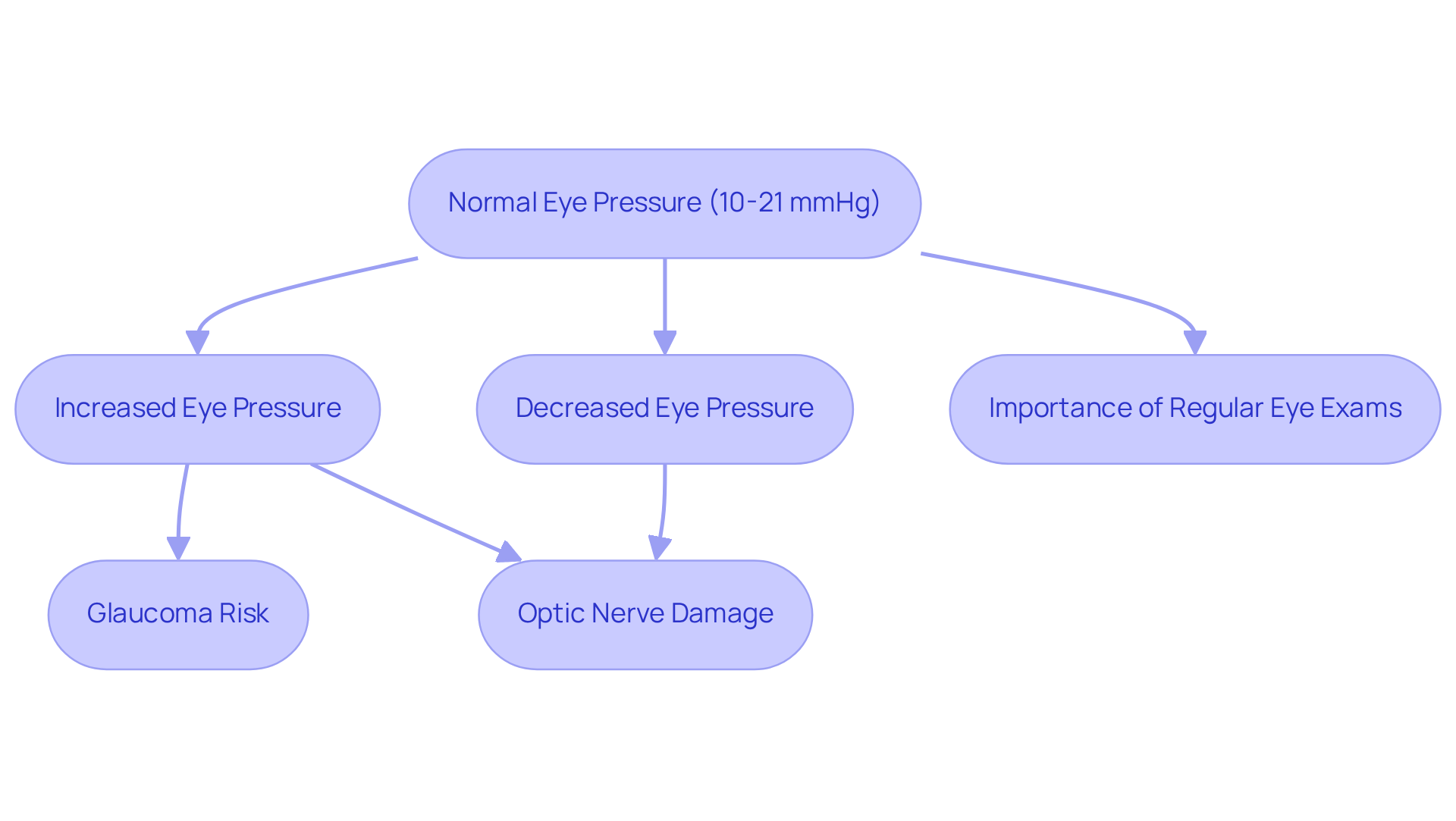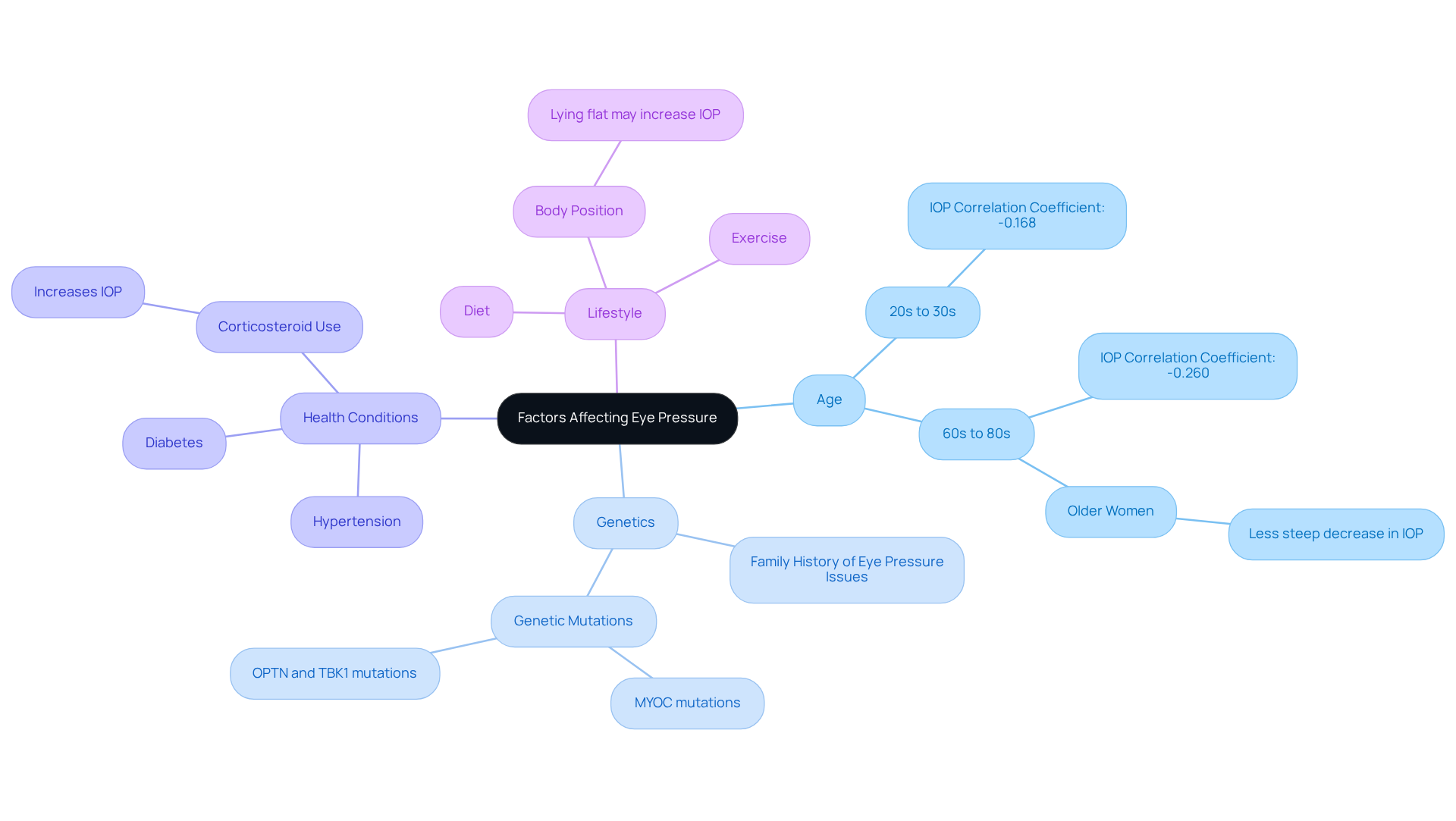Posted by: Northwest Eye in General on July 1, 2025
Overview
We understand that your eye health is a significant concern. Normal eye pressure, or intraocular pressure (IOP), is crucial for maintaining healthy vision. Typically, IOP ranges from 10 to 21 mmHg. It’s important to know that deviations from this range can lead to serious conditions, such as glaucoma.
Regular eye exams are essential to monitor your IOP. Both elevated and decreased levels can result in permanent vision damage. We encourage you to take proactive steps in managing your eye health. Remember, you are not alone in this journey; we are here to help you through this process.
Introduction
Understanding the delicate balance of intraocular pressure (IOP) is essential for maintaining optimal eye health. We recognize that many individuals may feel uncertain about what constitutes normal eye pressure, which typically ranges from 10 to 21 mmHg. This pressure plays a crucial role in safeguarding the optic nerve and preventing conditions like glaucoma. It’s common to feel overwhelmed by the factors that influence eye pressure, and we want to assure you that you’re not alone in this concern.
What are the hidden risks associated with abnormal eye pressure? If left unchecked, these risks can lead to serious complications. We encourage proactive monitoring and lifestyle adjustments to protect your vision. Together, we can navigate these challenges and prioritize your eye health.
Define Normal Eye Pressure and Its Importance
Normal eye pressure, which is known as intraocular pressure (IOP), is typically measured in millimeters of mercury (mmHg), with a normal range from 10 to 21 mmHg. We understand how important it is to maintain this balance for the health of your optic nerve and to . Both increased and decreased eye tension can lead to significant vision problems, including permanent damage to the optic nerve.
It’s common to feel uncertain about eye health, especially since many individuals may not notice symptoms until substantial damage has occurred. Regular eye exams are essential for monitoring IOP, and we encourage you to prioritize these check-ups. Remember, we are here to help you through this process and support your vision health.

Explore Factors Affecting Eye Pressure
Several factors can significantly influence intraocular pressure (IOP), which is crucial for maintaining eye health. We understand that this topic can be concerning, especially as we age. Age plays a pivotal role; as individuals grow older, their risk of developing elevated IOP increases. Research indicates that the correlation between age and IOP is negative, with a coefficient value of -0.168 for patients in their 20s to 30s and -0.260 for those in their 60s to 80s. This means that while IOP tends to decrease with age, the rate of decline varies across different demographics. For instance, older women exhibit a less steep decrease in IOP compared to their male counterparts, highlighting the importance of gender in this context.
Genetics also significantly impacts IOP levels. If you have a family history of eye pressure issues or ocular hypertension, it’s essential to be aware that you may be predisposed to similar conditions. Studies have shown that specific genetic mutations contribute to various forms of glaucoma, underscoring the need for genetic testing in at-risk populations. This knowledge can empower you to take proactive steps in managing your eye health.
Health conditions such as diabetes and hypertension further complicate IOP dynamics. These systemic illnesses can cause variations in eye tension, making regular monitoring vital. Moreover, prolonged use of corticosteroids is recognized to increase IOP. If you are on these medications, it’s essential to have your eye measurements assessed regularly to ensure your well-being.
Lifestyle factors, including diet and exercise, also play a role in IOP regulation. For example, certain dietary choices and physical activity levels can influence . Interestingly, body position can affect IOP as well; lying flat may increase pressure in some individuals, emphasizing the need for personalized eye care strategies. We encourage you to consider these factors as part of your overall health routine.
Comprehending these elements is essential for proactive eye health supervision, especially for individuals susceptible to eye conditions. Regular eye exams and consultations with eye care professionals can help mitigate risks associated with elevated IOP and ensure timely intervention. As one specialist observed, “The sole method to detect this eye condition early is through a thorough eye examination.” With glaucoma-related blindness affecting millions and costing the U.S. economy approximately $2.86 billion annually, awareness and education about these factors are crucial. Remember, we are here to help you through this process and support your eye health journey.

Discuss Implications of Abnormal Eye Pressure
Unusual eye tension can lead to serious complications that affect both vision and overall eye health.
We understand that concerns about eye health can be overwhelming. High eye tension, characterized by increased intraocular pressure (IOP), is a significant risk factor that can result in permanent vision loss if not addressed. Studies show that individuals with IOP levels of 22 mmHg or higher face a seven-fold increased risk of developing primary open-angle glaucoma (POAG). Unfortunately, symptoms often go unnoticed until substantial damage has occurred, which is why are so crucial for early detection.
It’s also important to acknowledge that low eye pressure, while less common, can lead to vision problems such as blurred vision and potential retinal damage. This condition may indicate underlying issues, including trauma or inflammation. For example, patients with low eye pressure may experience complications that could result in significant visual impairment if not treated promptly.
Regular eye examinations are essential for identifying these conditions early. We are here to help you through this process, enabling timely intervention and effective management strategies to preserve your vision and maintain your eye health.
Conclusion
Understanding normal eye pressure is crucial for maintaining overall eye health and preventing serious conditions like glaucoma. We understand that intraocular pressure (IOP) typically ranges from 10 to 21 mmHg, and both elevated and decreased levels can lead to significant vision problems. Regular eye exams are essential to monitor IOP and ensure the health of the optic nerve, reinforcing the need for proactive eye care.
Several factors influence IOP, including age, genetics, health conditions, and lifestyle choices. As individuals age, the risk of abnormal eye pressure increases, particularly in women. Additionally, systemic illnesses like diabetes and hypertension can complicate IOP regulation. Understanding these influences empowers you to take charge of your eye health through regular check-ups and informed lifestyle choices.
In conclusion, prioritizing eye health through routine examinations and awareness of factors affecting IOP is vital. With glaucoma and other conditions posing significant risks, embracing a proactive approach can help safeguard your vision and overall well-being. We encourage you to take action today for a healthier future for your eyes, making eye care an essential part of your personal health management.
Frequently Asked Questions
What is normal eye pressure?
Normal eye pressure, also known as intraocular pressure (IOP), is measured in millimeters of mercury (mmHg) and typically ranges from 10 to 21 mmHg.
Why is maintaining normal eye pressure important?
Maintaining normal eye pressure is crucial for the health of your optic nerve and helps prevent issues such as glaucoma. Both increased and decreased eye tension can lead to significant vision problems, including permanent damage to the optic nerve.
How can individuals monitor their eye pressure?
Regular eye exams are essential for monitoring intraocular pressure (IOP). It is important to prioritize these check-ups to ensure eye health.
What symptoms might indicate a problem with eye pressure?
Many individuals may not notice symptoms until substantial damage has occurred, making it vital to have regular eye exams to catch any issues early.
How can I receive support for my vision health?
It is encouraged to seek help through regular eye exams, and professionals are available to support you in maintaining your vision health.






